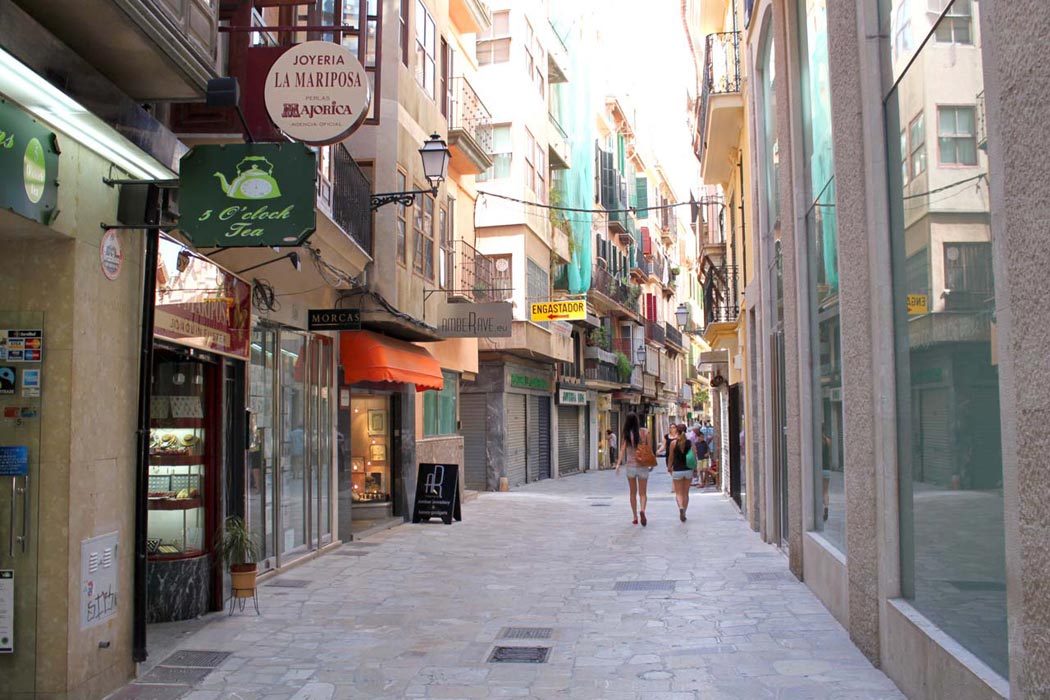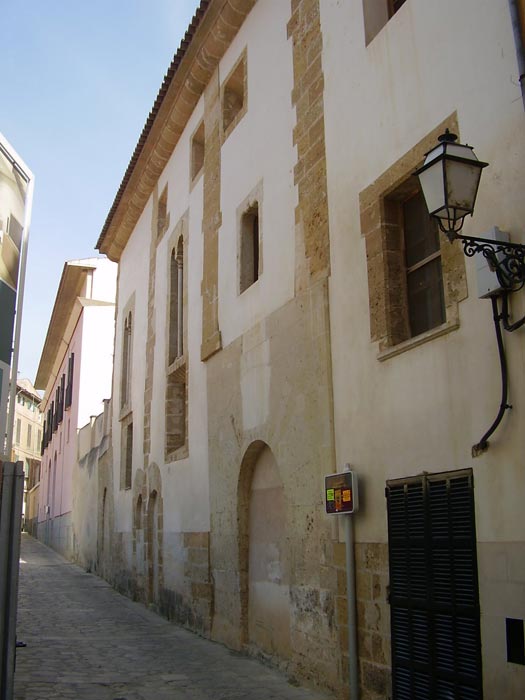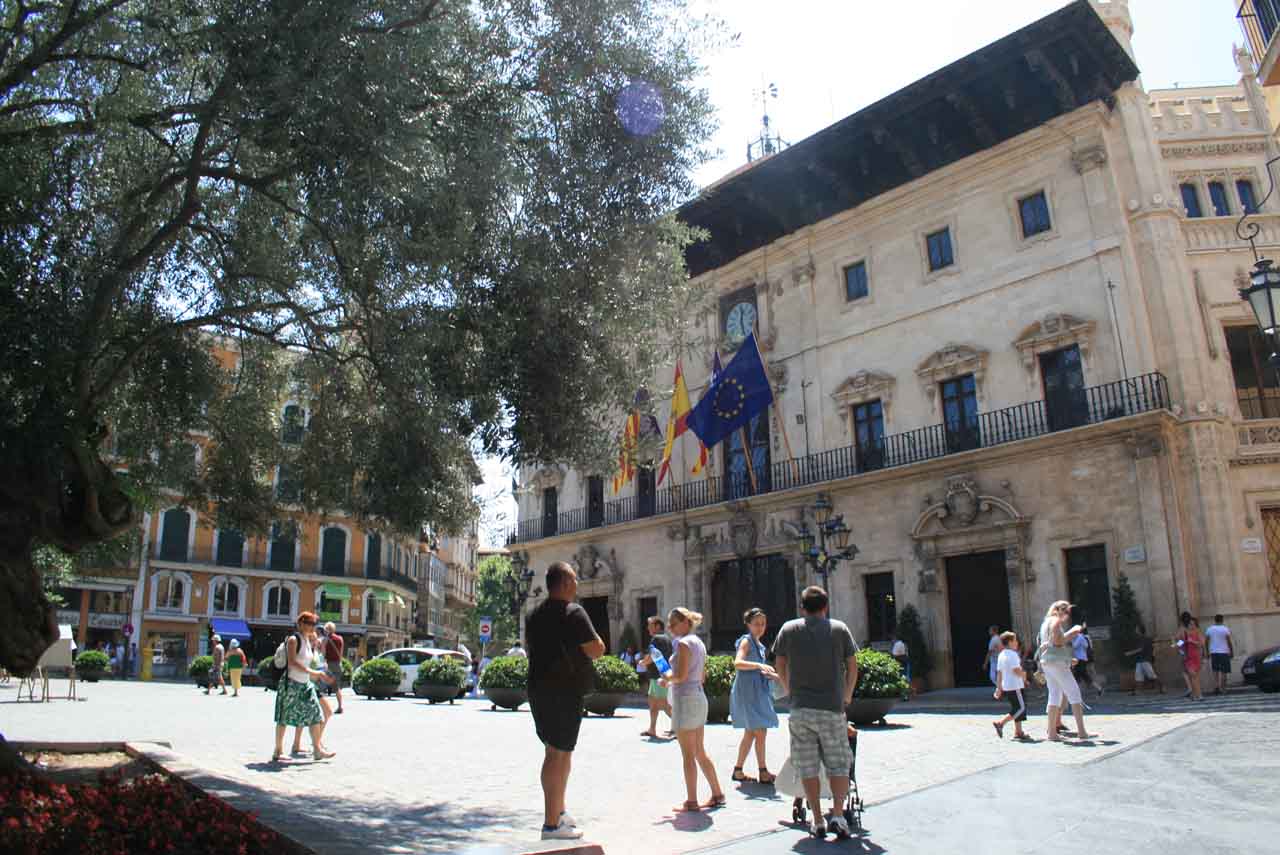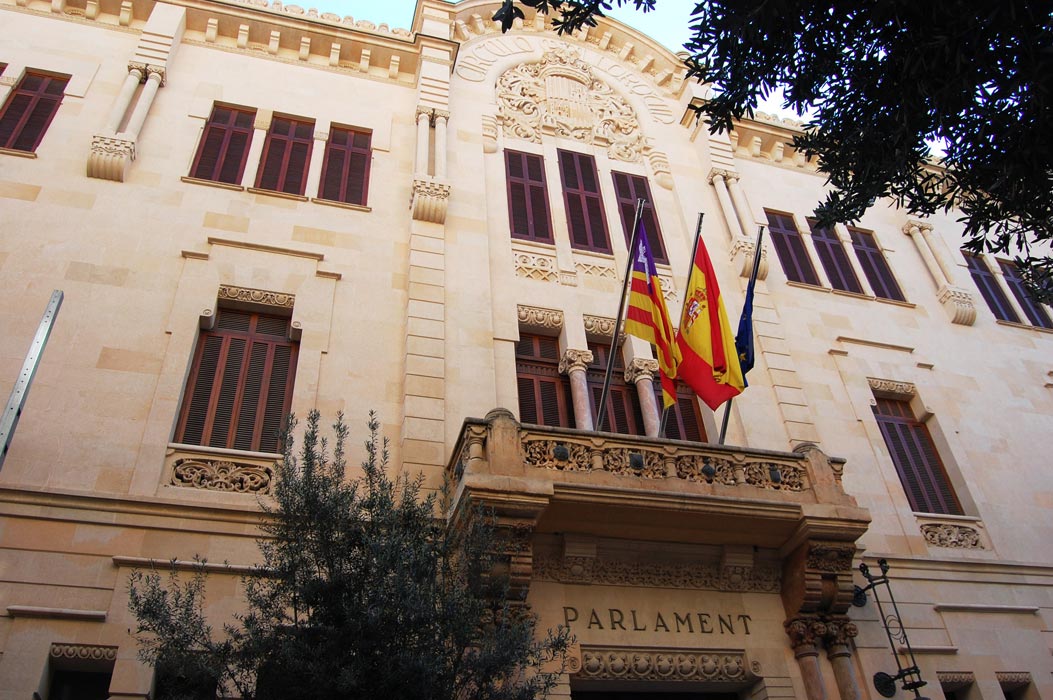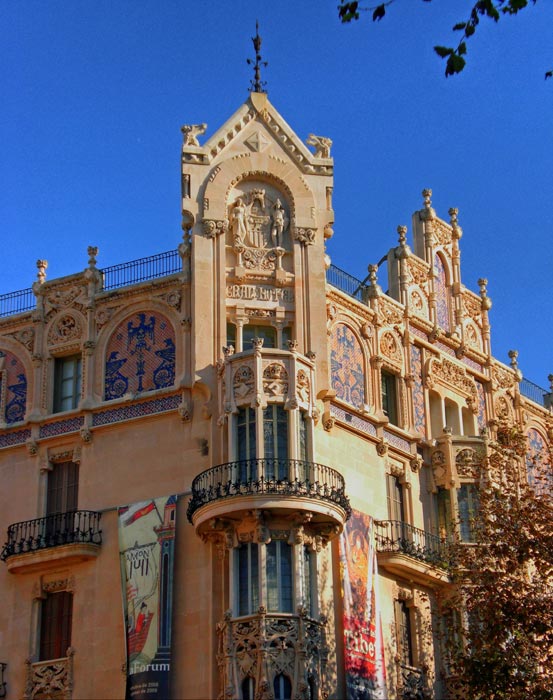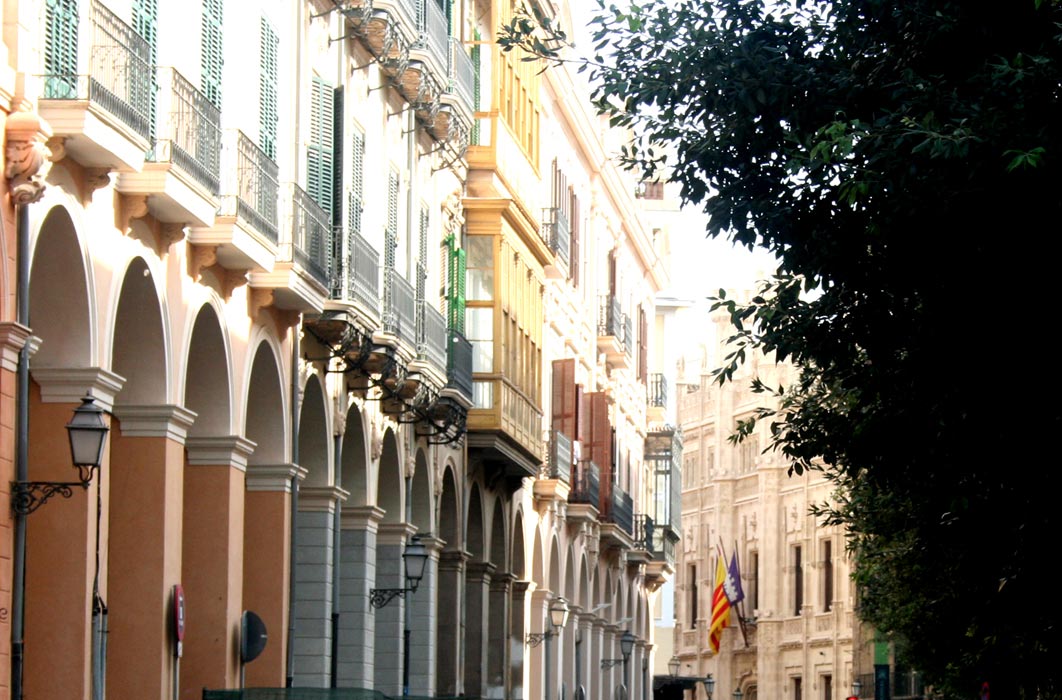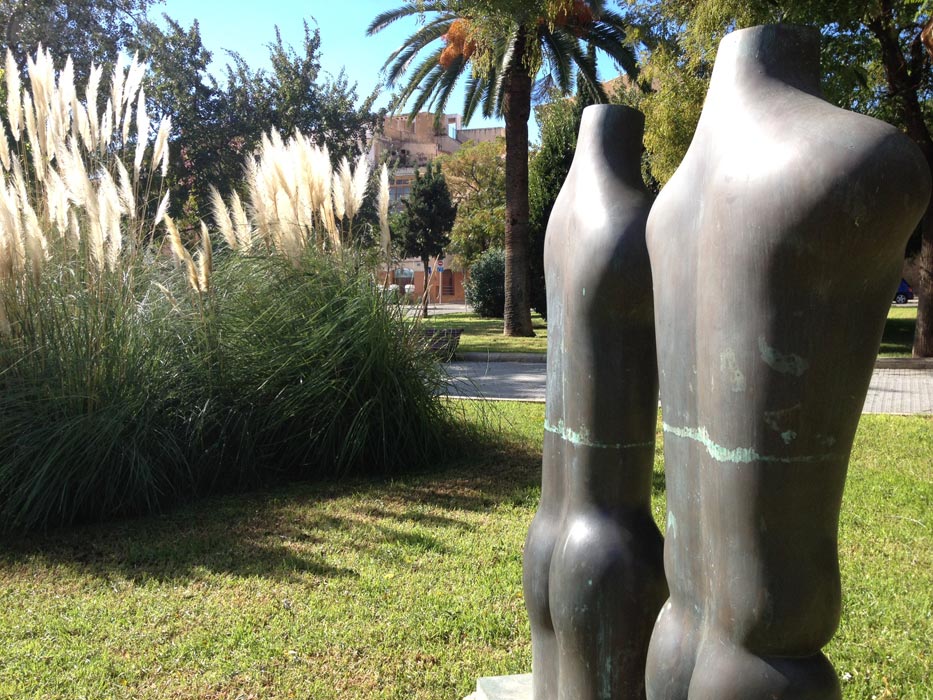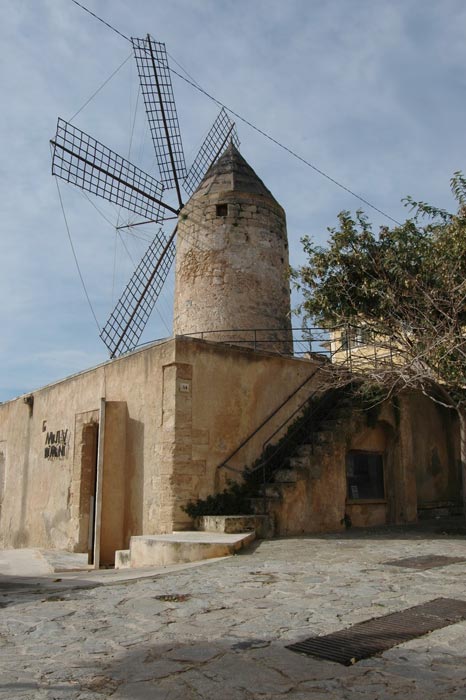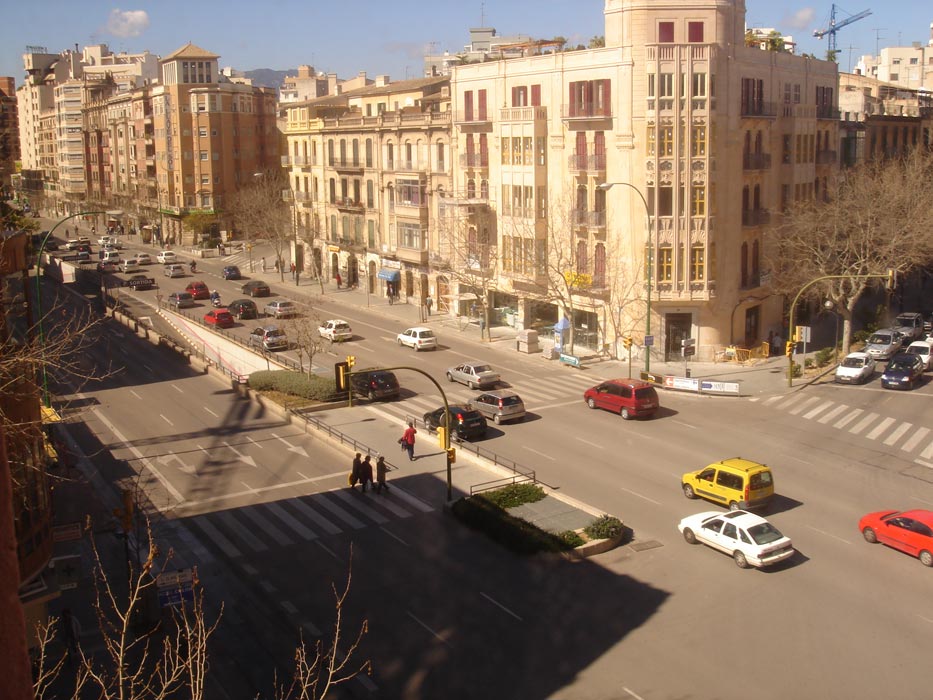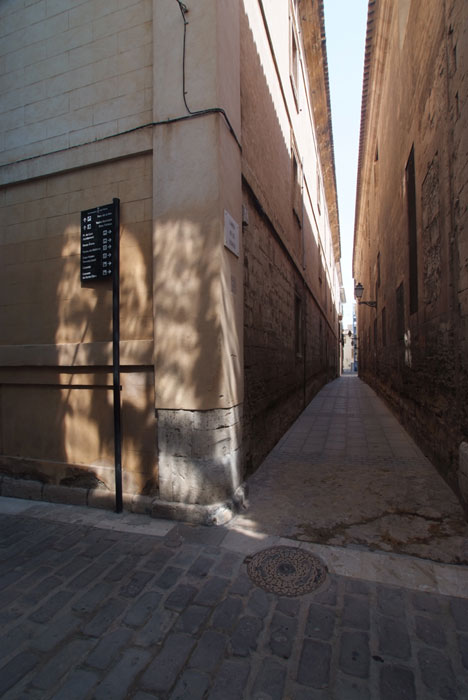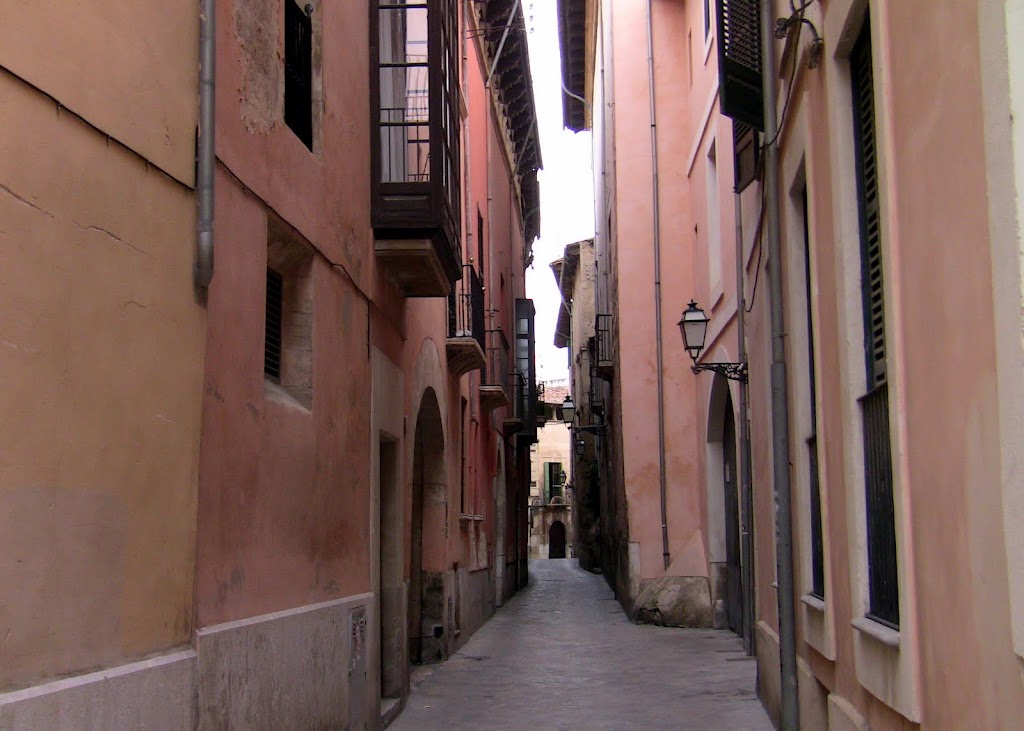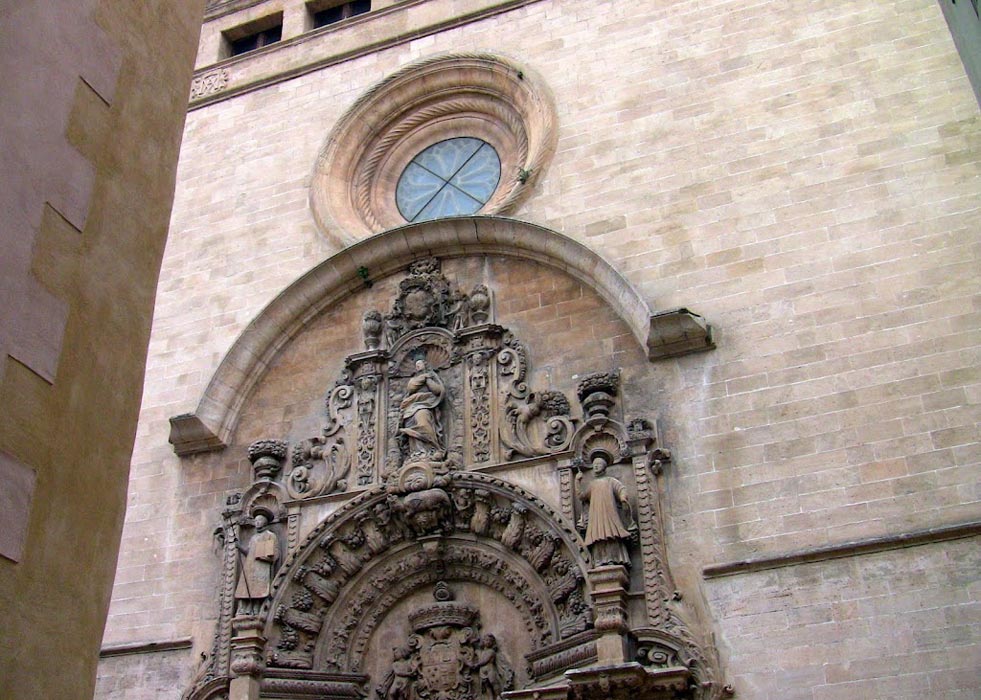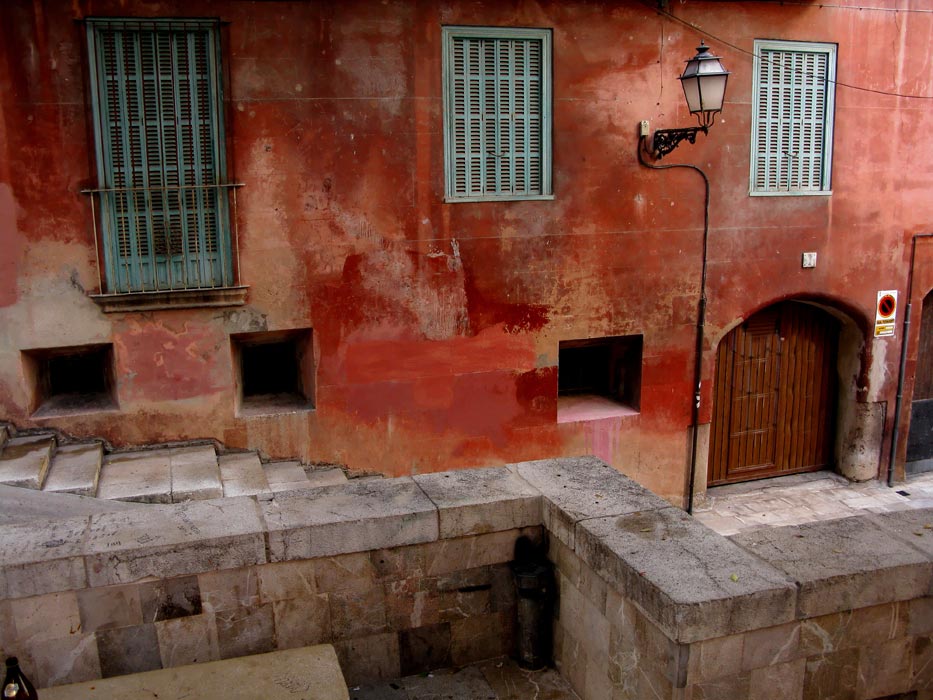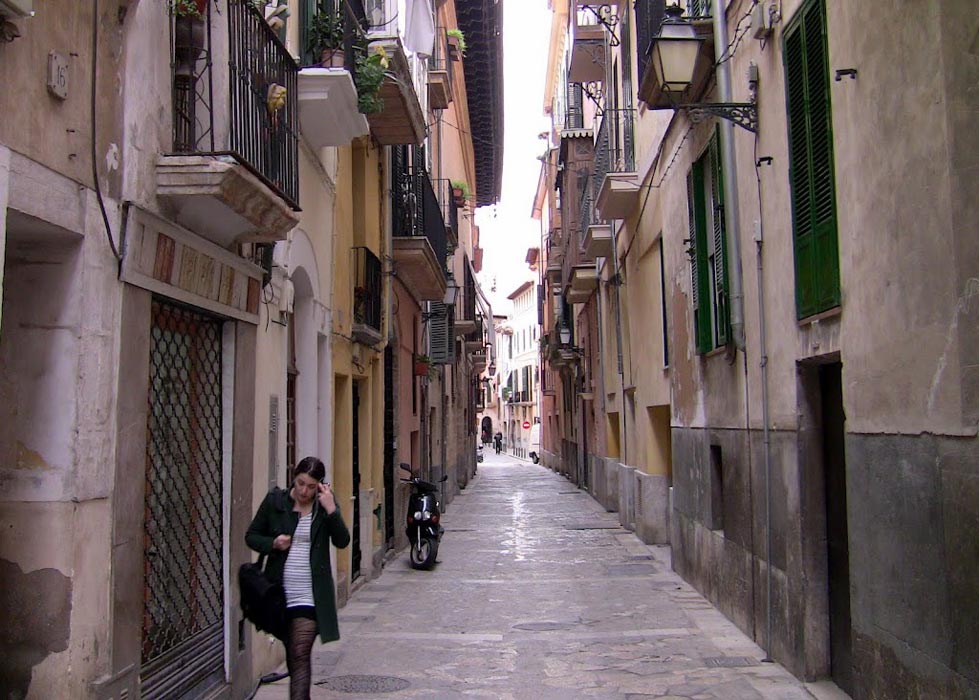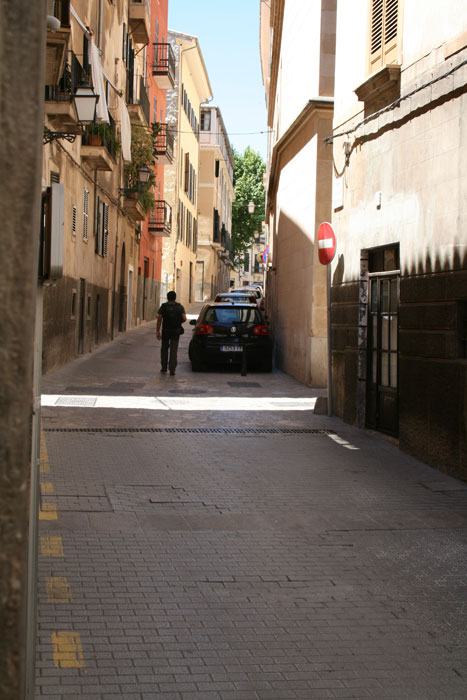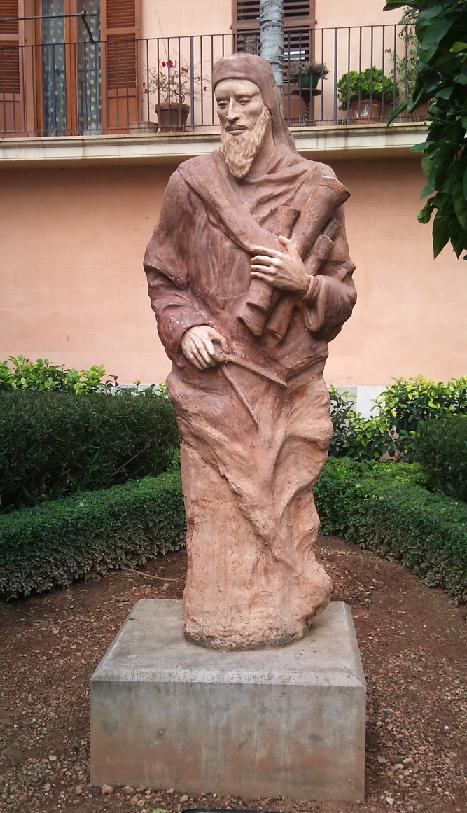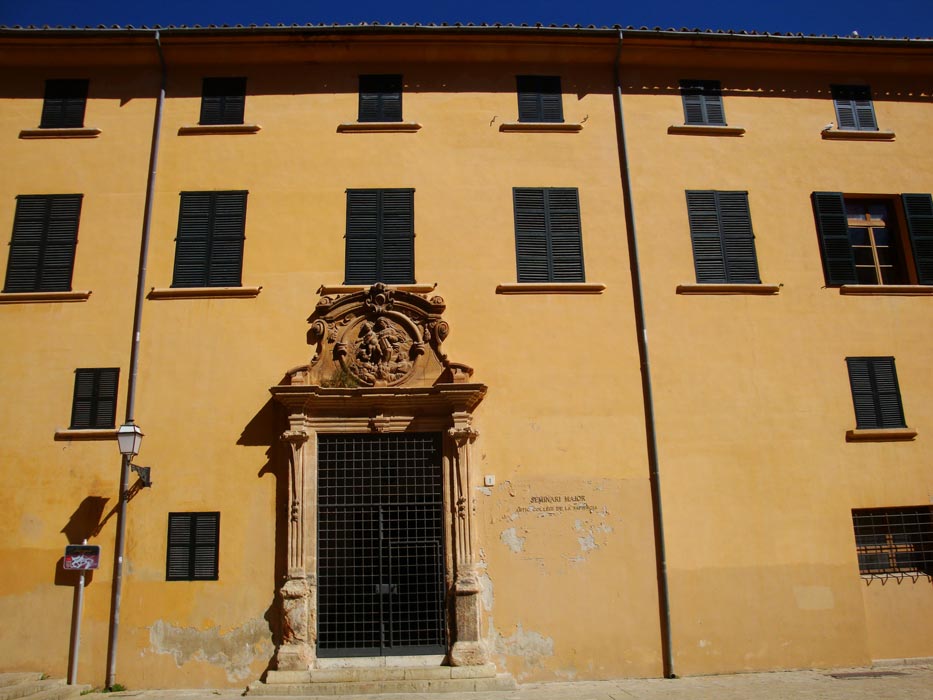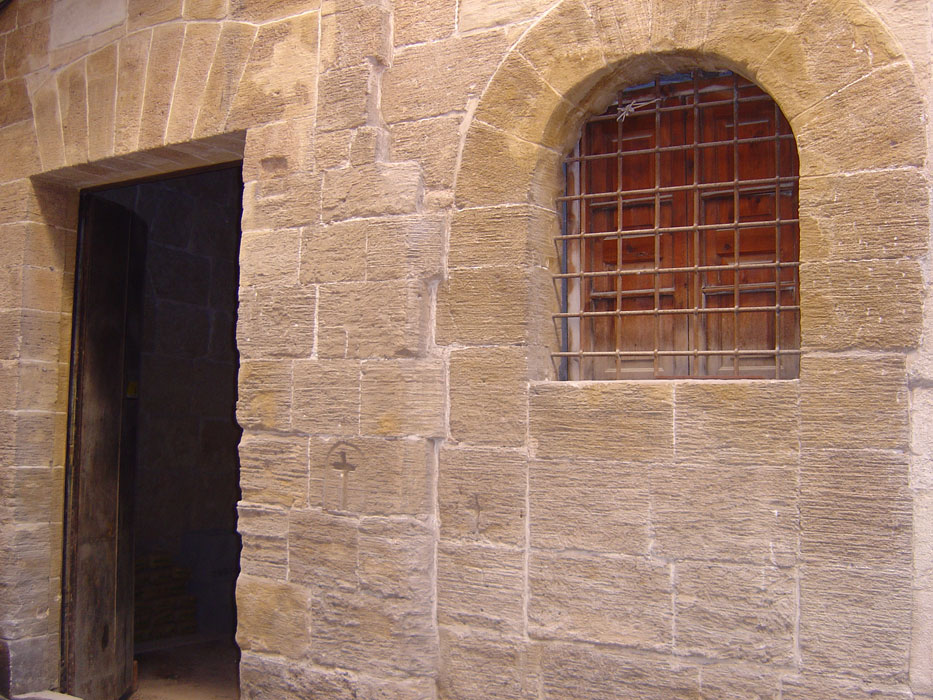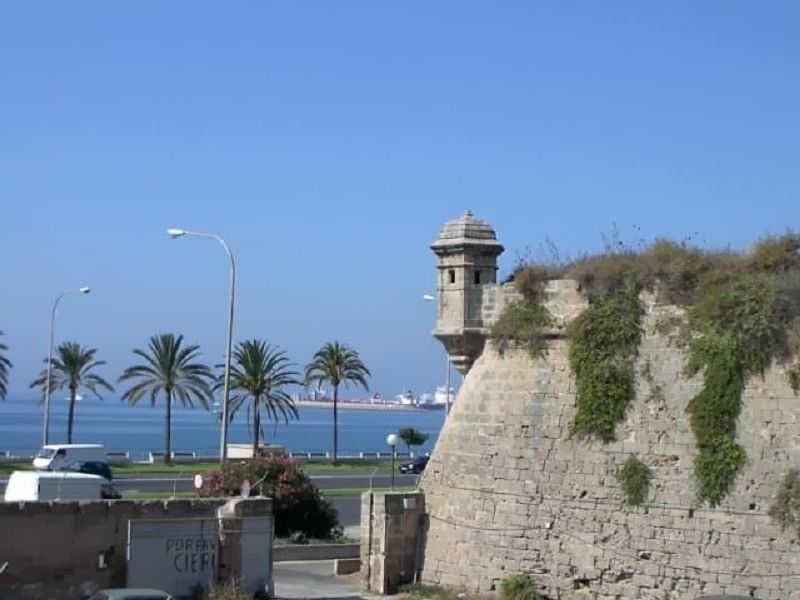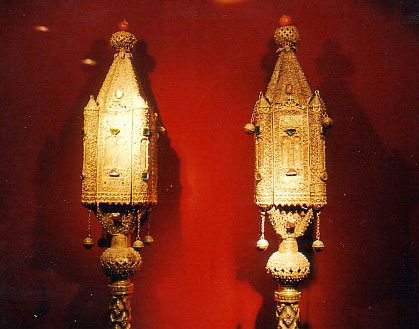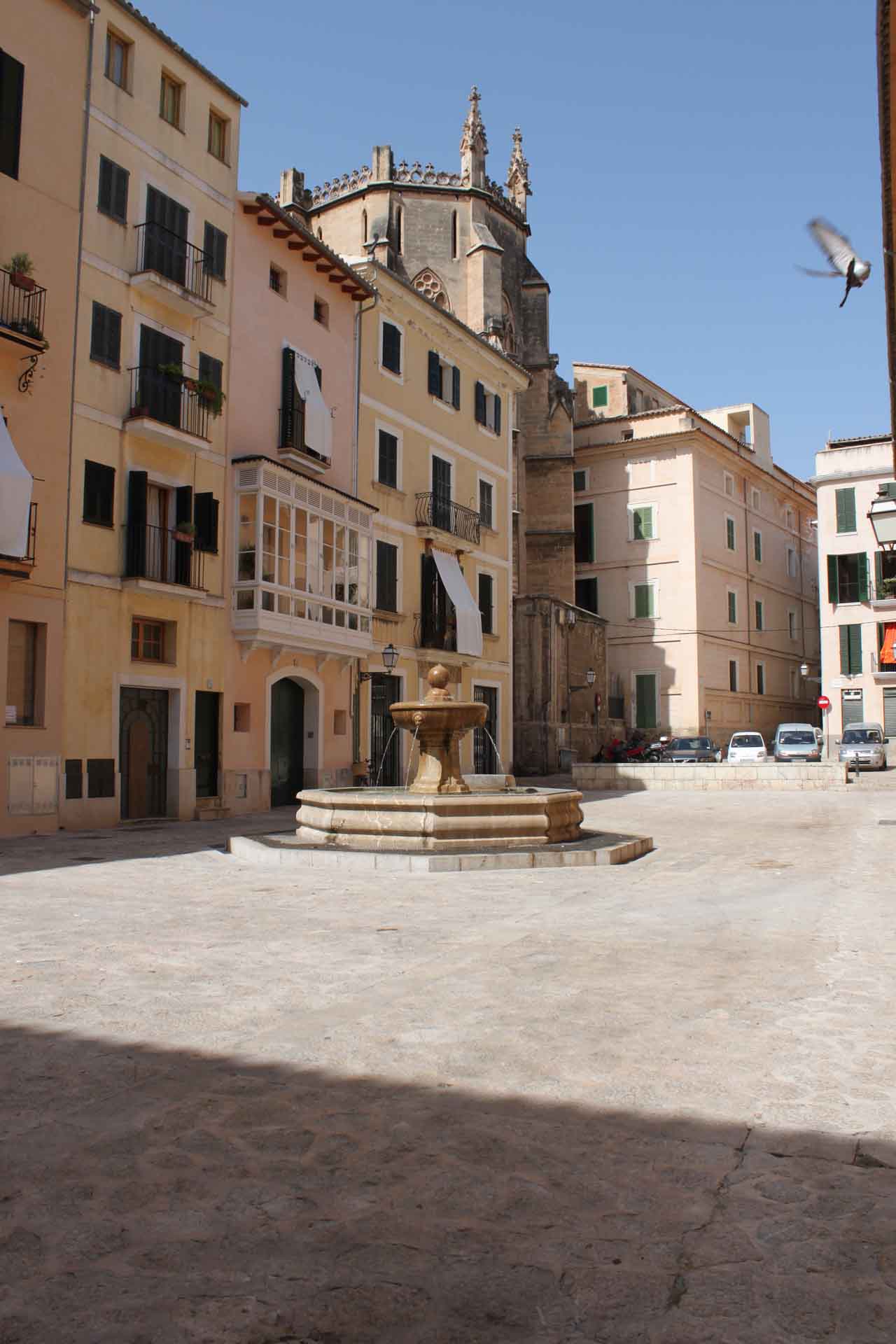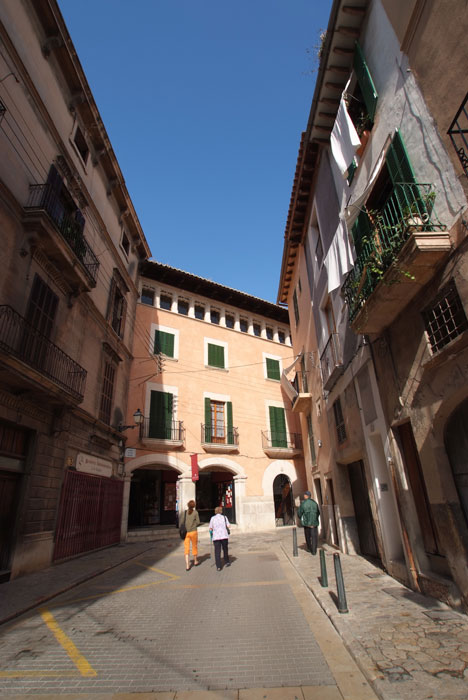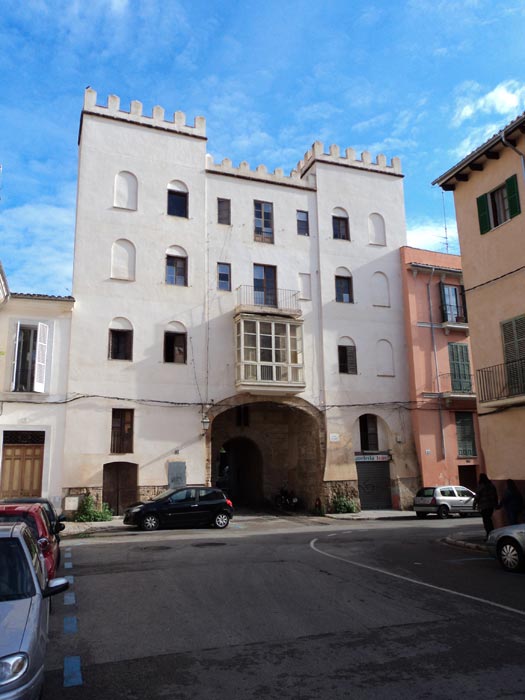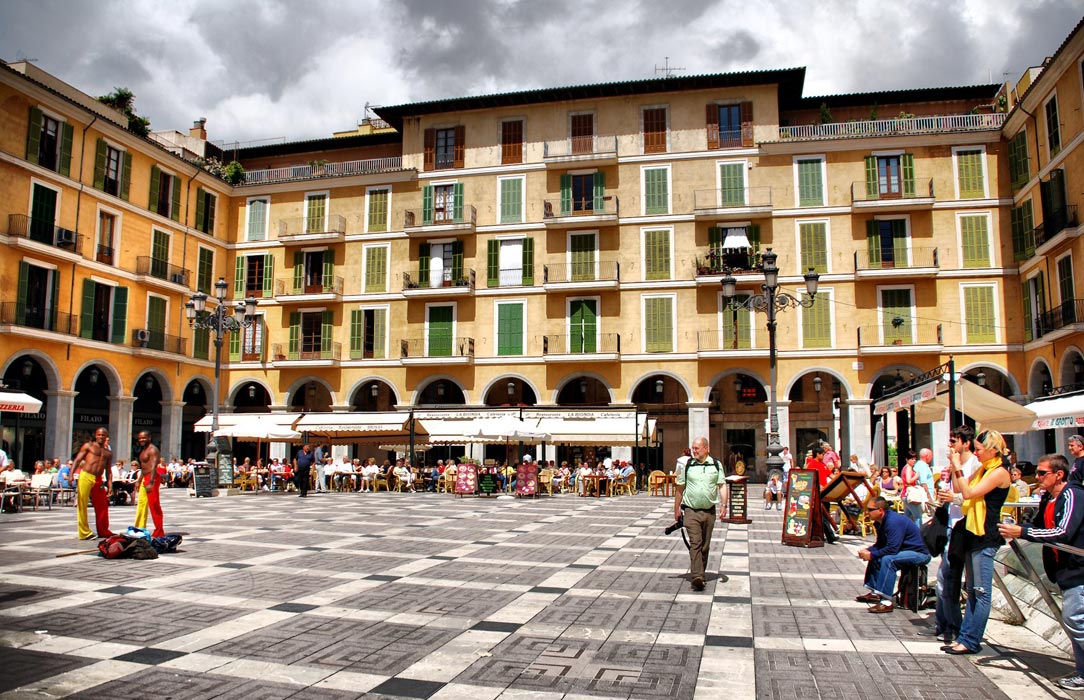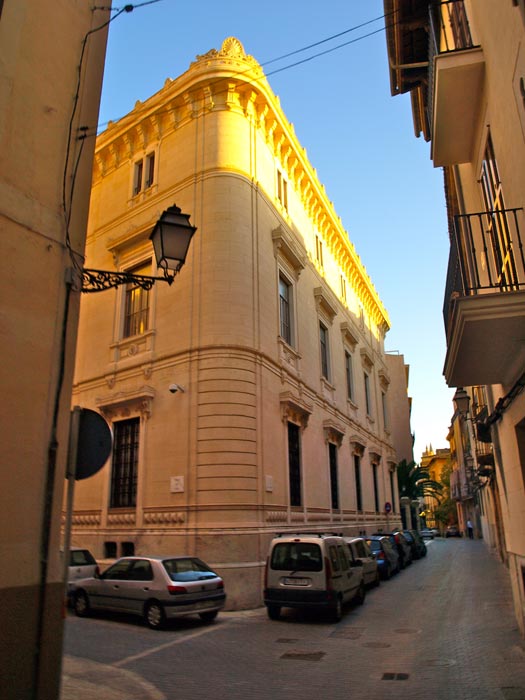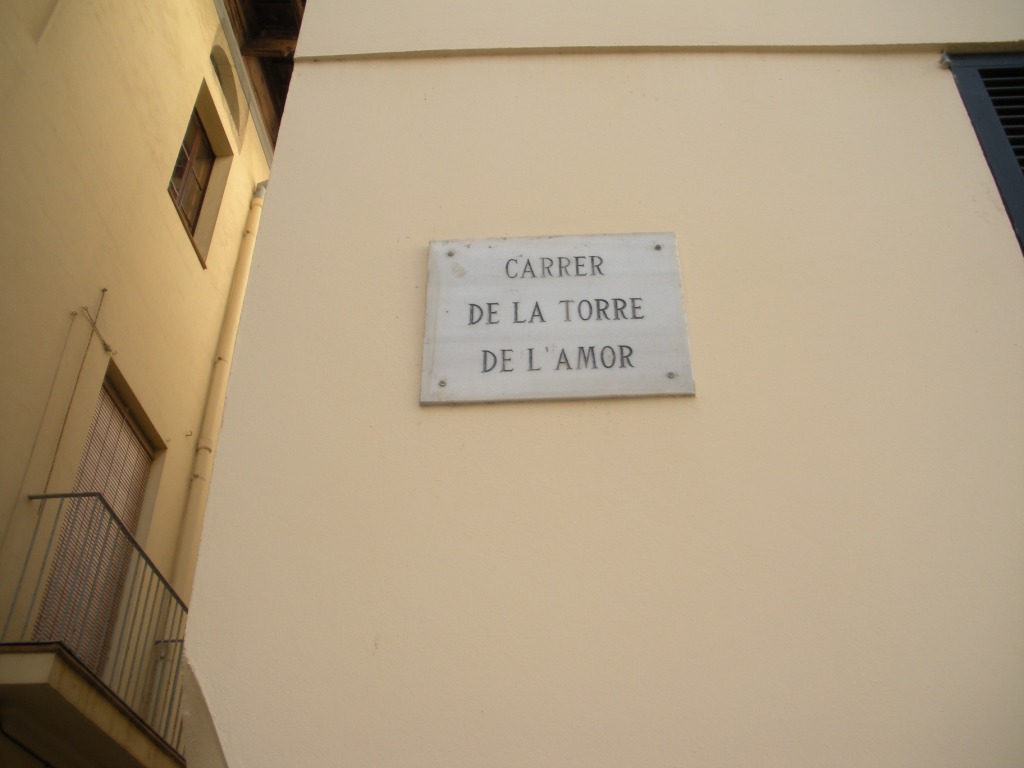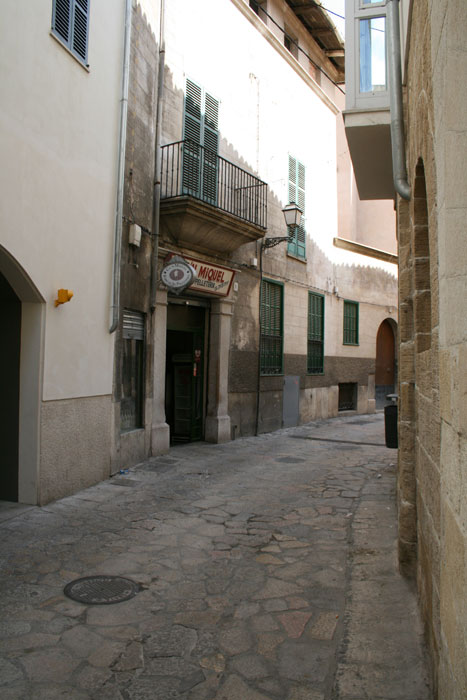In no Spanish city has the Jewish legacy managed to remain as intimately linked to
the everyday life of its inhabitants through the centuries as in Palma. The survival
until today of the community of xuetas or xuetes, the direct heirs of the last Jews forced to convert to Christianity in the late
14th century and early 15th century is graphically illustrated in the colourful commercial
streets of its former minor call where the jewellers and craft businesses keep an activity alive and kicking which
the Jews of that time also carried out. A hustle and bustle complemented by the magnificent
medieval mark of the main call where the layout of the main streets of that Jewish quarter are maintained and a large number of manor houses of the time.
The resistance of the descendants of the Majorca Jews to leaving Palma can largely
be put down to the very idiosyncrasy of the city as a capital which is open, commercial
and defined by its melting pot of cultures represented in the Mediterranean. As well
as how far the Jewish collective in the area goes back, with documentary evidence
dating back to the 5th century, when the Jews of Majorca already lived alongside the
Christians prior the Moslem domination as can be surmised from a well-known letter
from Bishop Severo from 417 in which it can be verified how in the 5th century the Jewish community
of Palma had notable political and economic power in Majorca. Three Hebrew inscriptions
found at Ses Fontanelles de Son Torrella (Santa María del Camí) and dated from the
4th or 5th century bear testimony to this presence since long ago.
It is likely that the Jewish settlement of Palma was destroyed when the Byzantine
general Belisarius expulsed the vandals in 534. After this date, there is no further record of a Jewish
presence in Majorca until the expedition to Majorca by Ramón Berenguer III in 1114
and the attack on the island´s capital. After the occupation of the Roman citadel
of Almudaina, the King accepted the surrender of all the Jews. We know that during the 12th century the economy and finances of this island were
almost totally in the hands of the Jewish community which had taken control of the
market and the exchange houses. What is for sure is that in 1228 when Jaime I undertook
the conquest of Majorca, there were still Jewish settlers on the island.
When Majorca was conquered between 1229 and 1234, the Jewish community must already have been important as it was a trading port in the Mediterranean and a Madina Mayurqa. After the conquest, it is widely accepted that the Jews received certain compensation
for their help during the conquest as set out in the Llibre del Repartiment (Book of Division). It is not known whether these Jews were native to the island or whether they had
come from the peninsula with the conquerors. It is now believed that the conquest attracted a large number of Jews to Majorca, of which a large number were from Tortosa, Vilafranca or Tárrega and also from Narbonne and Marseille. There is even word of Jews emigrating from Alexandria. The resettlement of the island after the formation of a government and the establishment
of the Church was one of the aims of the Crown of Aragon and so the King offered the
Jews all kinds of facilities for them to settle. The promotion of the immigration
of further Jews is documented by a royal decree dated June 11th 1247.
Jaime I granted the Jews full freedom and important privileges: he exempted synagogues from paying taxes and duties, afforded them a protection
framework and decreed that in proceedings brought against the Jews, the accusation
could not be based on solely Christian testimonies. Very shortly after the conquest
the aljama of Palma paid 300 sueldos malgoreses in taxes according to a document dated 1247. The aljama had become a last resort for the monarch when the royal coffers were running low
and he asked them for aid and donations. Hence, in 1263, by way of an agreement with
the collective of Jews, the annual sum of eight two pounds de Valencia was paid.
When confirming the privileges of the Majorcans on January 5th 1285, Alfonso III declared
them exempt of certain charges whereby he obtained a donation of 500 pounds, followed
by a further 1,000 in the subsequent year, plus a contribution of 1,500 pounds in
the other year. After the departure of the governor of the deposed King Jaime II, King of Majorca, Pons Saguardia, who had taken refuge
with his family in Almudayna de Gomera and houses of the Temple, the Jews requested
the King for authorization to occupy part of the uninhabited area near the main Call. To this end they paid 600 pounds in 1290.
When Jaime II recovered the crown after the sudden death of Alfonso III, the Jews
were inhabited the streets belonging to the Order of the Temple and Calatrava street
as far as St. Clare´s convent. Jaime II, on March 18th 1299 vouchsafed forever the permanence of said call and of the synagogue whose works had been commenced at the place designated by Bishop Pons de Jardi in its own demarcation and with the right to add the houses adjoining the Temple
if necessary in order to guarantee them that in the future they would not be forced
to leave the call to form another elsewhere. Although residence in the call was voluntary in theory, the King made it mandatory on May 23rd 1303, though they were still allowed to run their businesses outside the district, always subject to the strict obligation of eating and sleeping in houses in the call.
In the document in which Jaime II confirmed the obligation of the Jews´ residence
in the call on March 18th 1299, it was declared that construction work had begun on the corresponding
synagogue. Use of the synagogue, notwithstanding, lasted until the general confiscation decreed
by King Sancho of Majorca before September 19th 1315. When the Jews recovered their
private assets in return for the payment over time of 95,000 pounds, the synagogue
was not returned to the Jews but rather King Sancho turned it into the Christian chapel
of the Holy Faith. This conversion implied some urbanistic problems: the doors and
windows providing direct access to the chapel from adjoining houses had to be blocked
up, improvising an alley which connected the streets outside the call with the chapel set up in the centre of the Jewish district and even expropriating
some Jewish houses who became the residence of Christians.
Upon the death of King Sancho in 1327, a commission appointed by the aljama moved to Perpiñán to negotiate with Prince Felipe he setting up of a mint on the plot of the chapel of Holy Faith where the first synagoguewas located. The Royal Council, in exchange for a loan of 5,000 pounds, granted the
installation and allowed the sale of the houses adjoining the former chapel. The Mint was set up therein 1328 and it is known that in 1381 it was still located in this
place.
Since the early 14th century the Jewish call had undergone short periods of violence and continued attacks and the only thing
they could do was to protect the king who in 1306 offered refuge on the island to
some Jews expelled from France to whom in 1311 the new King Sancho had confirmed his
protection. In 1305 some anti-Jewish episodes occurred; in 1309 the Jews were condemned
because of the habitual slander regarding infamous practices and a bloody episode
occurred and in Inca it seems there were even some deaths. In 1314 other inquisitions
were again put into effect based on vague accusations that led to the confiscation
and closure of the synagogue. For half a century more the persecution by the Christian clergy seems to have been
unrelenting, but mitigated or neutralised by the royal authority.
The Jewish population in Majorca gradually increased during the 14th century. At the
end of the 13th century four to five thousand Jews were calculated as living in Majorca
and the two Jewish quarters of Palma must have accommodated between three hundred
and fifty and four hundred houses. In 1339 259 heads of household were recorded in
the aljama of Majorca in a document in which they were sentenced to pay a fine imposed by the
King but the list was not thorough as some members were exempted payment. In 1343,
going by the data of the morabatí, the Jewish population had attained 1,700 inhabitants and in 1350 after the black
death there were 2,600 Jews in Palma. The plague brought about immigration from the
towns of the island to the capital. On July 15th 1350 Pedro IV ordered Gilabert de
Centelles to cancel the provision dated August 25th 1346 requiring the construction
of a call in Inca where the greatest foreign Jewish community resided. The majority of Jews
of Inca who managed to survive the plague must have moved to the city. In any case,
the royal decision was reconsidered as in 1353 the formation of the call of Inca commenced.
In 1370 new rumours abounded about possible attacks on the call. In this same year some Jews were robbed, wounded and imprisoned by royal officials.
The famine prevalent throughout Majorca in 1374 brought about new attacks on the Jewish quarter and the expulsion of the Jews from the city was requested. The aljama intends to relieve the situation with the generous offer of paying more than its
share to charter ships to bring provisions from Catalonia, advancing the money to charter other ships which had to depart from Majorca to fetch
more food. The King was grateful and he confirmed that the Jews were «són tresor e cosa nostra propia».
On August 2nd 1391 during a wave of attacks on the peninsular Jewish quarters, a group
of peasants from the island who had camped on the outskirts of the city and who had
refused to disband - even setting upon the Governor himself – attacked the call. The slaughter cost between 180 and 300 Jewish lives according to some sources. The
attackers were claiming the abolition of all taxes and debts as well as the conversion of the Jews who they deemed responsible for the settlement´s ruin owing to their private debt
and credit activities. For two days had no governance and was in the hands of the
insurgents, led by the batlle of the city, Lluis de Belviure, who appears at the head of the popular rebellion against the institutions. Palma
call is sacked repeatedly and perhaps used as a store by the mutineers. On August 14th,
giving in to the pressure of the rioters, the jurors order the proclamation of the
abolition of taxes and the return of aid. Those Jews who had not been able to leave
the island took refuge at Bellver Castle, protected by the Governor and ten armed crossbowmen.
After the rebellion had died out, the Jews went back to the call and the Governor ordered the return of their assets and the gates of the call which had been torn off during the disturbances. On October 21st 1391 many families
had already been christened, taking Christian names and surnames. The fiscal and economic
conquests of the mutineers are derogated on November 22nd by the king from Vilafranca
del Penedés.
Despite the brutality of the events of 1391, the conversions were not as extensive
as has often been said. The call was not left totally uninhabited after the slaughter of 1391, but rather it was resettled,
at least partially, by part of the Majorcan Jews who had survived the attack. The
call, putting up with great disasters and ill treatment, was able to survive for about
another forty years. It survival was undoubtedly aided by the arrival of around one
hundred and fifty Portuguese Jewish immigrants. It was this collective that bought
the synagogue from Aaron Maní and rehabilitated it. It was situated in the current Pelleteria street
where Forn d´en Miquel is.
In 1413 the aljama suffered a serious infringement to their rights and in 1435 the King ended up forbidding
the practice of Judaism in Majorca, coinciding with a new financial era of the Crown
as it no longer needed the Jews´ collaboration to pay for campaigns. The request for
clemency for four Jews sentenced to death by the Governor (including the rabbi and Astruc Xibilí, the owner of the synagogue) sparked off the widespread conversion which occurred in 1435 and which was explained
to the people as the final triumph of the Catholic faith. Some were able to flee whilst
others began further torment which would last for centuries.
The official conversion to the Catholic faith in 1435 was something of a fiction.
The fact that these conversions were not carried out owing to any religious belief
mean that these new converts simply continued to practice Judaism in secret. In 1678 the Inquisition imprisoned
a group of over two hundred people accused of continuing to practice Judaism and in
1778 two hundred and twelve xuetes were caught Judaizing in a garden outside the walls owned by one of them. This survival
of Judaizing practices or at least the loyalty to a series of rites and traditions
of Jewish origin, not only led to the publication of the famous list of the 15 surnames
of xuetes, placing their sanbenitos at St. Dominic´s Convent, but it also meant that from that
time and until quite recently individuals in the street, as the chuetas were also known, formed a group which was constantly persecuted.
Former St. Dominic´s Convent
Balearic Islands´ Parliament where the former St. Dominic´s Convent was located, built
on the first Jewish quarter in Palma
The current Balearic Islands´ Parliament takes up most to what used to be the old St. Dominic´s Convent, settled, in turn, on the set of Jewish houses of Almudaina dels Jueus which the order obtained in 1236 from the hands of Prince Pedro de Portugal, though
the first stone would not be laid until sixty years later.
The Dominican convent where the sanbenitos of the converts sentenced by the Inquisition were placed, served this purpose for five centuries until this was ended by the Disentailment,
going into the hands of the Círculo Mallorquín after a few years.
During the almost forty years it took to build the convent, the Jews who lived at
the Citadel site, around it and at other places in the city, as stated in an order
by Jaime II (qui consueuerit morari et suas domos et habitaciones habere intus Almudaynam et in
altris locis ciuitatis Maioricarum) during the course of their various activities must have settled and spread around
various sites in the new Christian city, sometimes leaving and sometimes being turfed
out of their stronghold at the Citadel.
Court of the Holy Office of the Inquisition
Created by the Catholic Monarchs in 1478 and directly answerable to the Crown, the
Court of the Holy Office of the Inquisition saw to the upholding of Catholic orthodoxy in its kingdoms and operated in Spain
until its final abolition in 1834 during the reign of Isabel II.
The Inquisition, as an ecclesiastical court, only had jurisdiction over baptized Christians.
For the majority of its history though, as where was no freedom of worship in Spain
and its dependent territories, its jurisdiction extended to virtually all the subjects
of the King of Spain.
The Inquisition was created by means of the papal bullAd abolendam, issued in 1184 by Pope Lucius III after the synod of Verona as a tool for combatting the Albigensian heresy in the
south of France. As well as in France and Spain, there were pontifical Inquisition
courts in several European Christian kingdoms during the Middle Ages.In the Crown of Aragon a pontifical Inquisition Court operated according to a ruling Excommunicamus by Pope Gregory IX in 1232 during the time of Albigensian heresy; its main representative
was Raimundo de Peñafort. Over time its importance gradually became diluted and in the mid-15th century it
was an almost forgotten institution, even though it was legally in force.
No consensus has been reached about the reasons why the Catholic Monarchs decided to implement
the inquisitorial machinery in Spain. Researchers have come up with various hypotheses:
- To establish religious unity. In view of the fact that aim of the Catholic Monarchs was to create efficient State
machinery, one of its priorities was to achieve religious unity. Furthermore, the
Inquisition allowed the monarchy to play an active part in religious matters without
the intermediation of the Pope.
- To weaken the local political opposition to the Catholic Monarchs. Undoubtedly, many of those in the Crown of Aragon who were
against the setting up of the Inquisition did so invoking their own jurisdiction.
- To put paid to the powerful Judeoconvert minority. In the kingdom of Aragón members of influential families were brought to trial including
Santa Fe, Santángel, Caballería and Sánchez. However, this contradicts the fact that
Fernando himself still relied on many converts in his administration.
Jewish cemetery of Santa Margalida Gate
Joan March avenue where the Santa Margalida Gate was found
The Jewish cemetery of Santa Margalida Gate, in view of the very scant information we have discovered, has frequently been said
not to have existed. The sole written reference dates from 1361 and briefly refers
to a donation made by Bishop Antonio de Colell of a vegetable garden alongside the
drinking trough of the portal invasatoris and which was located opposite a Fossar dels jueus (Jewish cemetery).
In the area Joaquim Ma. Bover found in 1861 a tomb headstone near the aqueduct which, passing via the Santa Margalida gate, allowed the entry
of the water from the Town Fountain. Fidel Fita, who had the chance to see the inscription,
dated the headstone from its calligraphy in the 14th century. It was a one and a half
metre wide limestone piece fragmented into two segments and in truncated pyramid shape
according to a model which was very common throughout the 14th century. The inscription,
severely deteriorated, was made with characters of around 9 or 10 cm and the following
can be read:
Rabbi Moses Hakim, su recuerdo sea
bendito.
In the opinion of Josep Maria Quadrado, this may refer to Moses Faquí, the husband
of Floreta, who appears as the owner of a house adjoining that of Maymó Mahabub. This
notarial annotation allows us to assume he was alive in 1391 as Floreta is not said
to be a widow.
The piece was collected by the Monuments´ Commission and formed part of the Archaeological
Museum of the province which existed at that time. When the Museum disappeared the
headstone was stored at Lonja and it was kept there during the 1940´s and went missing
at an indefinite time.
The cemetery
The cemetery was located outside the walls at a certain distance from the Jewish district. The
chosen site:
- Must be on virgin soil
- Must be on a slope
- Be oriented towards Jerusalem
The Jewish quarter had to have a direct access to the cemetery to prevent the burials from having to pass through the interior of the city.
After 1492 the monarchs authorised (in Barcelona in 1391) the reuse of stones from Jewish cemeteriesas construction material. It is thus not unusual to find fragments of Hebrew inscriptions in several subsequent
constructions.
Despite the pillaging they suffered from the late 14th century, the memory of these
cemeteries has remained in the name in certain places, for instance, Montjuïc in Barcelona or Girona. We are aware of the existence of more than twenty medieval Jewish cemeteries. Others are only known of thanks to the documentation or the headstones conserved.
The one in Barcelona at Montjuïc was excavated in 1945 and 2000, the one in Seville
in 2004, the one in Toledo in 2009 and the one in Ávila in 2012.
New Synagogue
The Seminari Vell which backed onto the new synagogue
In 1331, once sixteen years had gone by without any public synagogue, the Jews started building a new temple, but son ran up against opposition in the
form of officers of the bishop who appealed to Pope Gregory IX´s decree that forbade
the erection of any new synagogues. King Jaime III was inclined to agree with the Jews but by replacing the term new erection with repair or reconstruction of the old one and changing the word synagogue to school or house of prayer.
The new synagogue was located behind the current Conciliary Seminar and was closed after the attack
of 1391, experiencing a second spell of activity between 1419 and 1435 with the final
conversion of the Majorcan Jews. After the attack of 1391, all the common assets of
the aljama (synagogue, cemetery, butcher´s, baths, hospital etc.) were subject to the royal treasury. A
commissioner was sent specifically to Majorca to take possession of everything and
thanks to the notarial act drawn up at the time a description of the synagogue´s situation
has been preserved:
En primer lugar, la sinagoga mayor del dicho Call, con multitud de casas que son de su propiedad y contiguas a ella, y que confronta
por una parte con la calle donde está la fuente del dicho Call, de otra parte con
la calle que va a la Calatrava, por otra parte con la casa de Cijan, y de otra parte
con la casa de Natan d´Osca y con cierta calle o pasaje en las casas de Axata.
Two years later, after the seizure of the synagogue, the premises of said new synagogue were bought from the royal treasury by the notary Joan Martí the right to use water
from the royal stream which ran through the interior of its site.
The synagogue
The synagogue (place of congregation, in Greek) is a Jewish temple. It faces Jerusalem, the Holy City, and it is a place for religious ceremonies, communal prayer, studying
and meeting.
The Torahis read at the ceremonies. This task is conducted by the Rabbis aided by the cohen or singing child. The synagogue is not only a house of prayer but also an instruction centre as it is there where
the Talmudic schools are usually run.
Men and women sit in separate sections.
The synagogue interior contains:
- The Hejal closet located in the east wall, facing Jerusalem, stored inside the Sefer Torah, the scrolls of the Torah, the Jewish sacred law.
- The Ner Tamid, the everlasting flame always lit before the Ark.
- The menorah, a seven-armed candelabrum, a habitual symbol in worship.
- The Bimah, place from where the Torah is read.


